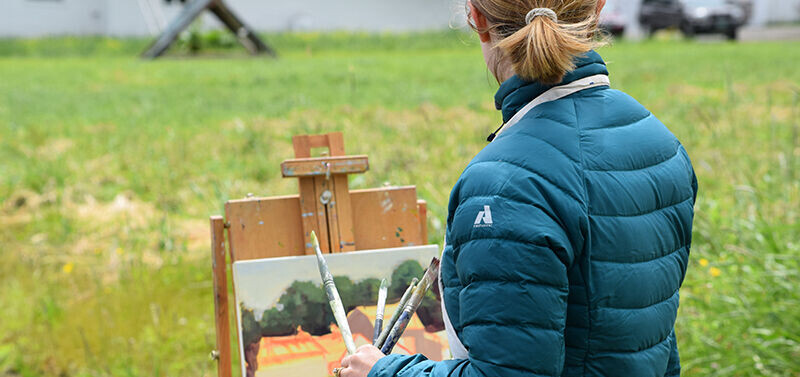Setting up for success with Plein Air Painting!

Painting en Plein Air can be challenging! But more than worth it!
Painting outdoors in the open air can be a frustrating and discouraging experience for a beginner. Even the most advanced plein air painters have experienced some overwhelming feelings when they first began painting outdoors. However you will discover that the struggles and initial failures are totally worth it.
A few common struggles of new plein air painters are:
• Simplifying the landscape and not being overwhelmed by the view,
• Seeing the actual color values under extreme lighting conditions
• Trying to include too much scene on a single canvas
• Using the appropriate amount of paint
A few tips for overcoming the initial difficulties of painting outdoors:
• Start small. Choose a simplified section of the landscape. Practice a lot!
• Start out with sketches of the composition you are thinking of painting.
• Ask questions of your fellow plein air painters. Don't be intimidated by other artists.
• Think of the experience of a "study" of color and atmosphere. Don't pressure yourself with having a finished piece within one session outdoors.
• Choose high contrasting compositions to paint. Look at the light and dark patterns as a puzzle. A viewfinder can be useful to find a appealing composition.
• Go easy on yourself and have fun!

Some tips from six outstanding experienced plein air painters; Kathleen Dunphy, Linda Glover Gooch, John Poon, Dave Santillanes, Kathryn Stats, and Colley Whisson gathered by John Pototschnik from an article in Outdoor Painter Magazine:
Kathleen: Don’t try to paint everything you see. Focus and concentrate on one clear intent per painting. Do several thumbnail sketches, cropping and enlarging, pulling back to focus or home in on smaller parts of the big scene. This exercise will help you determine what interests you most, and what not to paint.
Linda: Start with up-close and personal scenes. Don’t try to paint the whole Grand Canyon, just pick a small portion and learn from there.
John: Consign the entire scene to just three or four simplified masses. Group things together. The ground plane and hills, for example, can often combine to form a single large mass that separates from the lighter value of the sky. In this way, it helps organize the vast amount of detail, and keeps detail subordinate to the larger shapes of the design. Rather than painting every blade of grass, unify the area into a mass with broad brush strokes, then apply just a few details to define the subject.
Dave: Learn to see the “light family” and the “shadow family” independently in order to create an apples-to-apples comparison of color throughout a landscape. For example, if you can isolate your vision to only the shadows (or the darkest darks on each plane) and compare these dark shapes from background to foreground before painting them, you’ll have atmosphere figured out in very short order.
Kathryn: Paint all the darkest shapes first, then medium values, and finally, the lightest value patterns. Don’t get lost in minutia; for example, rather than draw every tree separately, find a way to group them as a mass into one large group. Limit detail. Hold off the most essential details until the last 1 percent of the painting.
Colley: Doing small thumbnail sketches is an ideal way to begin. Initially, it’s best to choose a subject that’s not too difficult and is within your skill level.
Source: https://www.outdoorpainter.com/overcoming-difficulties-painting-en-plein-air-tips

Plein Air Painting Suggested Supply List
Everyone should bring the following: Fold-up chair or stool, Camera or Mobile Phone, Water Bottle, Sun visor hat, Sun Block Lotion, Lunch, snacks. It will be helpful to
be able to carry all of your painting supplies in a small canvas bag to transport from spot to spot easily. Optional items are a view finder/catcher. Also, a jacket for the cool morning air.
Watercolors
Watercolor Paints and Brushes
Water Tub (collapsible is nice)
Easel and/or Lap clip board
Paper Towels
Tape
Mechanical Pencil Eraser
Sketch Paper
Watercolor Paper Pad and/or Notecards
T-square Ruler
Oils or Acrylics, or Gouache
Oil Paints or Tube Acrylics/Gouache and Brushes
Canvas Pad or Panels
Turpentine or Container for water
Retarder (acrylics)
Easel and/or Lap clip board
Paper Towels
Palette Knife
T Square Ruler
Mechanical Pencil
Eraser
Palette Paper or Water Palette
Dry Box (for oils to keep separated while drying to transport home) -optional
Opportunities for Plein Air Painting with ArtisTree:
ArtisTree Plein Air Painting Group, Fridays throughout the summer from 9am-12pm. Rain or shine. This is not a class but rather a painting group that meets at various places in the area to draw or paint. Please email Marie at communications@artistreevt.org to get on our mailing list! Click here for more.
Painting en Plein Air with Daniel Gottsegen. One-week intensive - Monday, July 29 - Friday, August 2 | 9am - 12pm - Cost: $175. Click here to sign up.